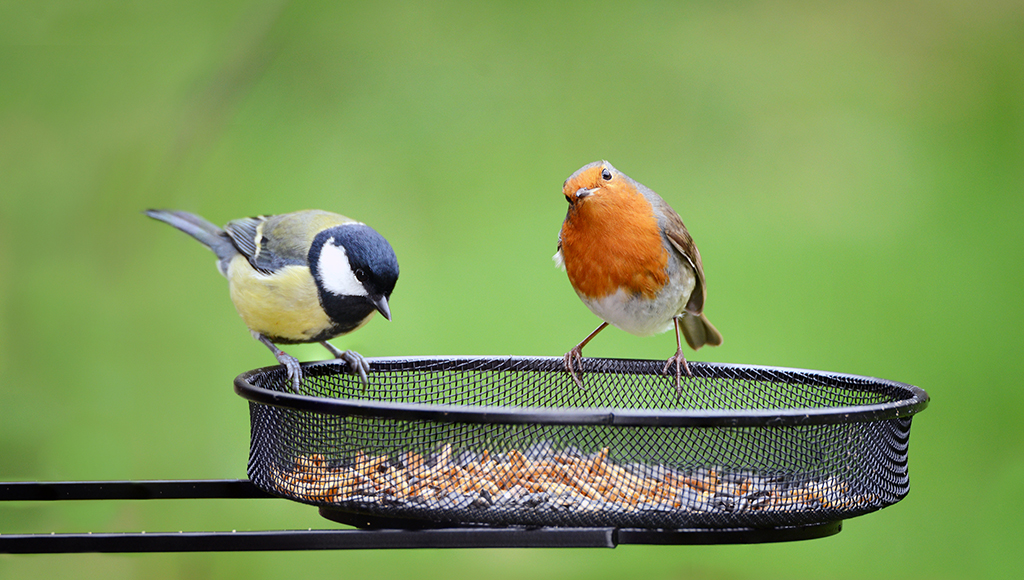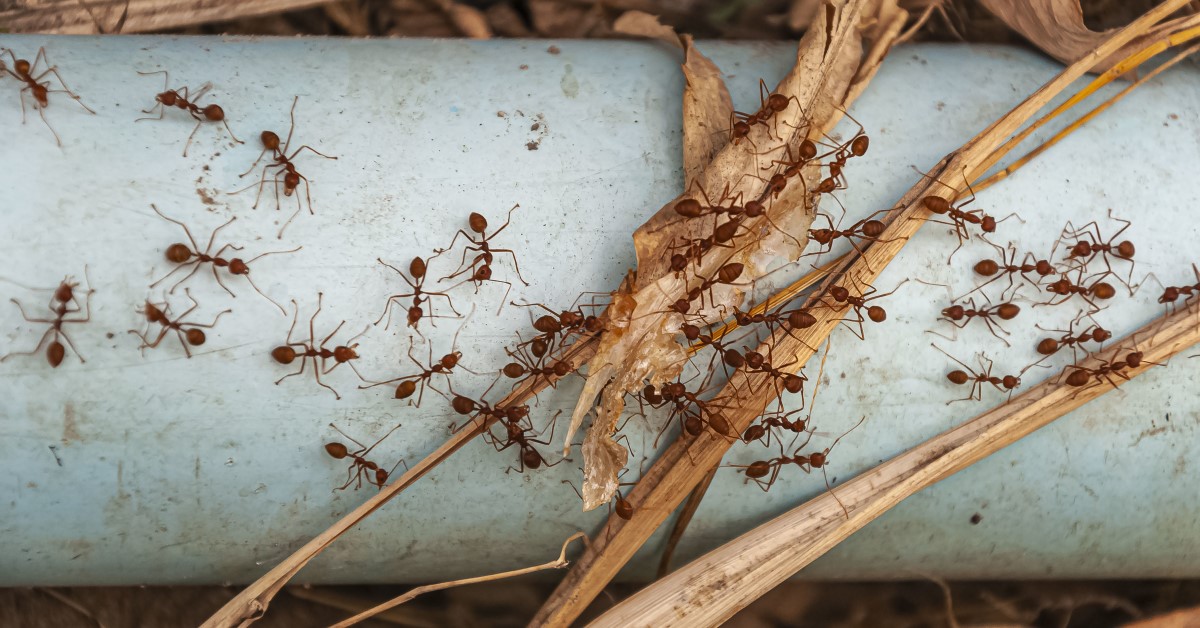Care and Feeding of Wild Birds
This is a rewarding activity the entire family can enjoy!

If you have a bird feeder in your backyard, you're in good company. Bird watching is one of America's fastest-growing hobbies, and surveys show that nearly half the households in the United States provide food for wild birds. With their colorful appearance and lively, cheerful attitude, it's obvious why we love to have them around, especially during the winter months when the weather is cold and dreary. By feeding birds we bring them close so we can see them more easily, plus they can be quite entertaining.
Setting up a backyard bird feeder can make birds' lives easier, too. In much of North America, winter is a difficult time for birds. Finding food can be especially challenging during periods of extreme cold. What should you serve your winged visitors? Should you control the amount of food you give them? These are common questions, and seeing the wide variety of bagged bird feed stocked on store shelves can make the task seem a little daunting. Once you understand the type of bird feeders and the types of birds likely to be attracted to the various types, the choices will be easier to make.
Things to Consider
The easiest way to attract birds to your yard is to put up a bird feeder. There are many different ones on the market today. Most are made for seeds, but there are also specialty feeders for certain foods, such as sugar solution for hummingbirds, suet, or peanuts. Knowing which to choose depends on the kinds of birds you wish to attract.
When choosing which type of bird feeder you will use, make sure that is is sturdy enough to withstand winter weather, tight enough to keep seeds dry and large enough to avoid having to fill it too frequently. Plastic or metal feeders usually meet these criteria much better than wooden feeders, but it still really comes down to personal choice.
If you want to attract more than one variety of birds to your yard, you will have to use several different types of feeders and a variety of seeds. Another thing you'll have to consider when selecting bird feeders, is making sure you dissuade the bird species you don't want around your yard.
Types of Bird Feeders
- Tray or platform feeder - any flat raised surface onto which food is spread.
- Hopper feeder - platform with walls and a roof, forming an enclosed location which protects food from weather and squirrels.
- Tube feeder - usually clear tube which attaches to a window with a suction cup; great for tiny species.
- Large cylinder feeder - similar to tube feeder, but with multiple holes with feeding perches beneath each opening.
- Nyjer feeder - special tube feeder designed with extra small holes to dispense tiny seeds such as thistle or niger. Some of these feeders even use a mesh bag which birds can cling to as they feed.
- Wire-mesh cage or plastic-mesh bag feeder - can be nailed to or tied to a tree trunk, or suspended from a high place.
- Bottle feeder - can hold an artificial nectar or sugar solution for feeding hummingbirds. These usually have little plastic screens over the feeding ports to act a as "bee guards".
- Saucer-shaped feeders - hummingbird feeders with the ports on the top, making them bee and wasp-proof. These feeders are better than bottle feeders in direct sunlight.
Which Bird Food Do I Want?
Because there are so many different kinds of bird feed available, it helps to know what type of food the various species eat. Certain species may even have different food preferences in different parts of their range.
Various Seed Types
- Corn - dried whole kernel corn is a favorite food of jays, pigeons, doves, turkeys, pheasants, and quail. Cracked corn is easier for smaller birds to eat, and will attract blackbirds, finches, and sparrows, as well as the larger birds mentioned above.
- Millet - there are two types of millet: red and white. Most birds find white proso millet more attractive than the red variety. Millet appeals to many ground-feeding birds, such as doves, juncos, and sparrows. Millet also attracts undesirable non-native species such as European Starlings and House Sparrows.
- Milo - large, reddish, round seeds of milo (or sorghum) are often used as "filler" in birdseed mixes. Most birds will only eat it if there's nothing better. Be aware that it also may attract undesirable aggressive birds such as cowbirds, starlings, and grackles.
- Safflower - a particular favorite of cardinals, safflower is often more expensive than sunflower seed. Grosbeaks, sparrows, and doves also like it. It's sometimes suggested for dissuading undesirable species because it may have less appeal to starlings, House Sparrows, and squirrels.
- Nyjer - (sometimes spelled "niger") is commonly known as thistle seed, although it's unrelated to native thistles. Its tiny seeds attract small finches such as goldfinches, siskins, and redpolls. Nyjer is expensive, so it's best offered in specially-designed thistle seed feeders, which have tiny feeding ports that prevent spilling and dissuade larger birds.
- Sunflower Seeds - Black-oil sunflower seed is the all-round favorite for bird feeders, particularly attractive to tree-dwelling birds. It has a high meat-to-shell ratio and is high in fat. Small size and thin shell make it easy for small birds, such as the Black-capped Chickadee, to handle and crack. Striped sunflower seeds are larger and have thicker seed coats, making them more difficult for small birds to process.
- Peanuts - titmice, chickadees, nuthatches, woodpeckers, cardinals, jays, many sparrows, and even Carolina Wrens are attracted to peanuts. They can be offered shelled or whole. Peanut feeders are specially-designed wire-mesh cages, often cylindrical.
- Mixed Seed - is best sprinkled on the ground or onto platform feeders. Mixed seed typically contains high quantities of millet, preferred by ground-feeding birds. Many feeder birds will not eat millet. Likewise, ground-feeding birds that favor millet will not have access to it if it's in a feeder. Try filling hanging feeders with sunflower seeds and spreading mixed seed for ground-feeding birds.
- Hummingbirds and Nectar - flower nectar is the principle natural food of hummingbirds. If you provide hummingbird feeders, you will need to make your own artificial "nectar." Since hummingbirds also eat insects, you don't need to purchase expensive commercial hummingbird nectars that have added vitamins and minerals. A sugar solution is adequate.
- Suet - is particularly attractive to woodpeckers, such as the Red-bellied Woodpecker, but many insect-eating birds such as nuthatches, chickadees, wrens, creepers, kinglets, and even cardinals-are fond of it too. It's a high-energy food, much appreciated in cold weather. Suet is the hard fat surrounding beef kidneys. It is inexpensive and available from butchers and at many supermarket meat counters. Commercial suet cakes are manufactured from "rendered" suet, a process in which it is melted, cooked, and strained, making it less prone to melting and spoilage.
- Fruit and Fruit Seeds - birds such as robins, thrushes, waxwings, and bluebirds usually don't visit seed feeders because seeds are not a major part of their diet. But you can attract them with fruit. Mockingbirds, tanagers, and catbirds may be attracted too. Try raisins or currants softened by soaking in water. Offer diced fresh fruit, such as apples, melons, or grapes. Orange halves are particularly desirable, especially to orioles, which also go for grape jelly. You can also save your Halloween pumpkin seeds, and other squash or melon seeds, for the birds. Some relish these more than black-oil sunflower seeds. Spread them out to let them dry and then run them through the food processor. This makes it easier for smaller birds to eat them.
- Leftovers - birds also will eat stale bread and other leftovers. Just make sure they're not moldy or they may harm the birds. Be aware, too, that table scraps may attract nuisance species such as European Starlings, House Sparrows, rats, or raccoons.
Artificial "Nectar" Recipe:
To make sugar solution for hummingbirds, add one part sugar to four parts boiling water (boil the water before measuring, because some water will evaporate away in the process). When the mixture is cool it is ready for use. You can store extra sugar water in your refrigerator for up to one week, but left longer it may become moldy.
Don't add red food coloring to the sugar solution—it is unnecessary and possibly harmful to the birds. Red portals on the feeder, or even a red ribbon on top, will attract the hummingbirds just as well.
Important Tips for Sugar Solution:
- Change the solution every 3-to-5 days to prevent mold and deadly fermentation.
- Clean the hummingbird feeder often.
- NEVER use honey or artificial sweeteners in hummingbird feeders. Honey grows mold that can be dangerous-even fatal-to hummingbirds and sweeteners will not provide the energy and nutrition that birds require.
- Do not put any kind of oil around feeding portals to deter insects. Oil may contaminate the nectar or get on the birds' plumage ruining its insulating properties.
Store your bird food carefully. If you buy a lot of seed, keep it in a dry, cool place, in a rodent-proof, metal can. Check the seed often for mold. Throw out any seed that is questionable.
Choosing and maintaining your wild bird feeders is an easy and rewarding activity that the entire family can enjoy, especially children. Once you begin feeding wild birds, you will find yourself addicted to caring for these delightful creatures.
Ready to start saving money on pet wellness care?
Then take a look at Mint Wellness, the pet wellness plan that provides fast reimbursement on routine pet care. Save on vaccinations, wellness exams, preventatives, dental, and more!
Learn More


